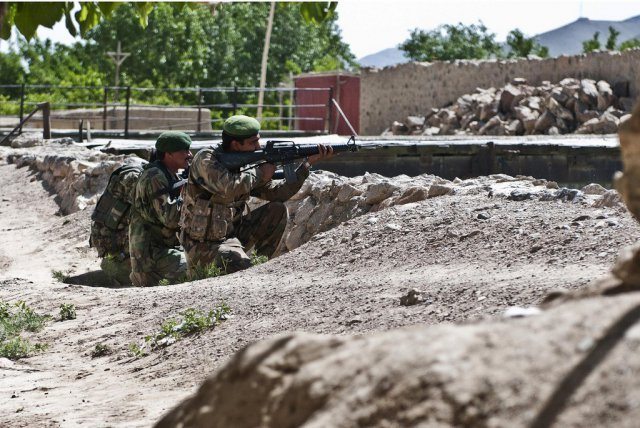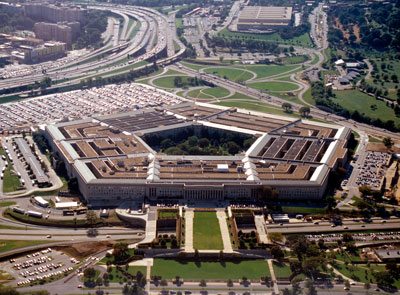As helicopters lifted off the moonlit field, Soldiers blended into the surrounding landscape. Slowly, each infantryman rose to his feet and scanned his sector of fire. As platoon leaders motioned to move out, night-vision optics revealed the flashing infrared lights attached to each Soldier as they formed a single line.
Soldiers of Blackhawk Company, 2nd Battalion, 4th Infantry Regiment, 4th Infantry Brigade Combat Team, 10th Mountain Division, Task Force Warrior, and Afghan National Army troops moved though orchards and farmland toward the Chak district center, unaware of the fierce enemy opposition they would encounter during the 48-hour Operation Compass, May 15-16, 2011.
Operation Compass was initiated to assess villages and the security of Chak district, which is located in central Wardak province. Company B previously worked to secure hostile areas in and around the Tangi Valley and recently redirected attention to Chak district.
“We are working to expand the security bubble along Route-1 by pushing further out,” said TF Warrior commander Lt. Col. Thomas S. Rickard.
Afghan National Policemen met TF Warrior and Afghan Soldiers at the district center and immediately began taking up security positions. Soon after the sun climbed over the tall peaks of the Hindu Kush Mountains, the valley erupted with mortars, rocket-propelled grenades, rockets and recoilless rifle fire from insurgent fighters.
U.S. and Afghan Soldiers returned precise small arms and 60mm mortar fire into the lush farmland, where Taliban fighters were concealed.
Rickard explained that Chak has the second highest population of southern Wardak and is a major economic and cultural center for locals. As a large community center, it is vital that Chak’s residents receive security and support from the Government of the Islamic Republic of Afghanistan, or GIRoA, he said.
Gunfire and explosions rang out throughout the first day of the operation. Once they identified Taliban mortar positions, motormen assigned to Co. B rained precision fire on them, but mortar sites located in more densely populated areas required a different strategy.
JTACs, or joint terminal attack controllers, are airmen assigned to Army infantry units who direct aircraft from the front lines. The JTACs relayed coordinates and other information to fighter jets circling high above the battle field. Within minutes, the first 500 pound JDAM, or joint direct attack munition, hit its mark, destroying an enemy qalat.
Fighting continued until after dusk, and then Afghan and U.S. troops regrouped and prepared to move deeper into the valley. Though moving into areas that have had limited GIRoA presence is dangerous, it is vital, said Rickard.
“Pushing into these hostile areas is important because we have to get these key districts under GIRoA control,” he said.
As the near-full-moon climaxed, U.S. and Afghan Soldiers began their movement south toward the Chak Dam. Platoon by platoon, the men quietly moved through lush fields, avoiding streets and trails. The occasional pot-shot rang out as insurgents prodded blindly into the darkness trying to get a reaction out of the disciplined warriors.
After crossing the dam, Company B commander Capt. Mark J. Balboni directed his men to take up security positions in a school compound. As dawn approached, Soldiers rotated between resting and providing security.
Then, just before 8 a.m., a large explosion rattled the concrete area Soldiers sheltered in.
“Most people wake up to the smell of coffee, but we wake to explosions and shrapnel,” said Sgt. Freddy T. Hughley, a combat medic assigned to Blackhawk Company.
Machine-gun fire accompanied the battlefield alarm clock and each Soldier leapt to his feet to take up firing positions around the compound. Civilian activity was absent from the village streets as the fierce battle from the previous day continued throughout the second. U.S. forces dropped three more JDAMs and placed mortars onto enemy positions the last day of the operation.
“Chak seems worse than Tangi so far,” said Pfc. Alexander Duckett, a rifleman assigned to Co. B. “This place has been everything we expected.”
That night, TF Warrior Soldiers and their ANA counterparts once again assembled and moved through thick vegetation toward an improvised helicopter landing zone. AH-64 Apache Helicopters moved into the area to assist with securing the landing zone, and minutes later CH-47 Chinooks landed. Soldiers moved quickly into the helicopters and moments later were on their way back to their combat outpost.
Although the previous two days were filled with immense firefights and indirect fire, TF Warrior Soldiers were able to stave off serious injuries.
With the success of this mission, Company B is able to build upon it and slowly increase the reach of the GIRoA security bubble, said Rickard.











